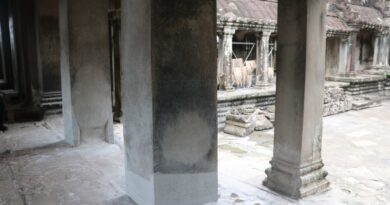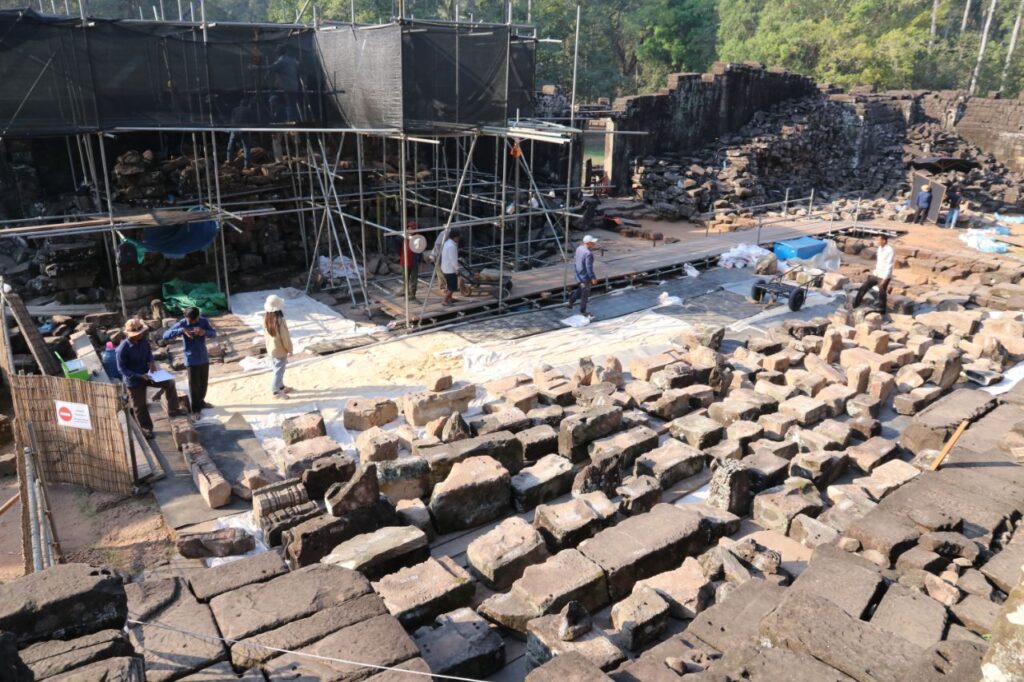ក្រុមអ្នកជំនាញជួសជុលនៅខឿនរួតទី១របស់ប្រាសាទបាយ័ន ឱ្យដឹងថា ក្នុងចំណោមថ្មចំនួនប្រមាណ២០០០ដុំ គរនៅទីតាំងខាងត្បូងឆៀងខាងលិចប្រាសាទបាយ័ន ដែលចាប់ផ្តើមរើតាំងពីពាក់កណ្តាលខែមករា ឆ្នាំ២០២៤ ត្រូវបានរកឃើញចំនួនជាង៤០០ដុំ ដែលអាចកំណត់អត្តសញ្ញាណបានថា គឺជាថ្មធ្លាក់មកពីថែវទី២ និងកំពូលព្រហ្មមុខបួននៅជ្រុងនិរតីនៃប្រាសាទបាយ័ន។ ប៉ុន្តែ ចំពោះថ្មជាច្រើនទៀត គេមិនទាន់ដឹងថា មានប្រភពមកពីណានៅឡើយ។
បុគ្គលិកជួសជុលប្រាសាទរបស់អាជ្ញាធរជាតិអប្សរា និងជាអ្នកជំនាញរកថ្ម លោក ញ៉ុក ឡូ ឱ្យដឹងថា ក្នុងការរើគំនរថ្មទិសខាងត្បូងប៉ែកខាងលិចរបស់ប្រាសាទបាយ័ននៅជំហានដំបូងនេះ បានរកឃើញថ្ម និងអាចកំណត់អត្តសញ្ញាណជាច្រើនប្រភេទដូចជា ថ្មផ្តែរ ថ្មចិញ្ចើមព្រហ្ម ថ្មទងត្រចៀករបស់ព្រហ្មមុខបួន ថ្មសរសរពេជ្រ ថ្មហោជាង និងដំបូលរបស់ប្រាសាទបាយ័ន។ ដោយឡែក ថ្មមានចម្លាក់ជាទងត្រចៀក បបេមាត់ទាំងនោះ បានជ្រុះធ្លាក់ពីកំពូលមុខព្រហ្មលេខ២៧ រួមទាំងធ្លាក់ពីថែវទី២ ដែលនៅទល់មុខ និងគំនរថ្មនេះតែម្តង។ អ្នកជំនាញរូបនេះ បញ្ជាក់ទៀតថា ចំពោះដុំថ្មដែលអាចកំណត់អត្តសញ្ញាណបាន គឺត្រូវរៀបទុកមួយផ្នែកសម្រាប់យកមកផ្គុំគ្នាឡើងវិញ។ រីឯថ្មមួយចំនួនទៀត មិនទាន់អាចកំណត់អត្តសញ្ញាណបានត្រូវទុកដាច់ដោយឡែកជាបណ្តោះអាសន្នសិន។
ស្ថាបត្យករ និងជាអ្នកគ្រប់គ្រងការដ្ឋានជួសជុលខឿនរួតទី១ប្រាសាទបាយ័ន កញ្ញា ម៉េង សុវណ្ណលីលីន ឱ្យដឹងថា មុននឹងឈានដល់ការជួសជុលថ្មកម្រាលដែលស្រុត និងជួសជុលប្រព័ន្ធបង្ហូរនៅទិសខាងត្បូងឆៀងខាងលិចនៅរួតទី១នៃប្រាសាទបាយ័នឡើងវិញ ជាដំបូង ក្រុមការងារត្រូវរើគំនរថ្មដែលនៅខាងក្រោយជញ្ជាំងរោងទងនៃទីតាំងជួសជុលជាចាំបាច់។ ការងារជំហានទី១ គឺត្រូវចុះបញ្ជីថ្មនីមួយៗ និងរើម្តងមួយៗ បែងចែកទៅតាមប្រភេទថ្ម ដើម្បីងាយស្រួលរកតួនាទី និងទីតាំងរបស់វា លើកលែងតែថ្មដំបូលទាំងអស់ហ្នឹងត្រូវយកចេញទៅខាងក្រៅ រៀបគរលើគ្នាឱ្យមានសណ្ដាប់ធ្នាប់ អ្វីដែលយើងចង់បាន គឺរកឃើញផ្នែកខាងលើបំផុតនៃតួប្រាង្គមុខបួន។
កញ្ញា ម៉េង សុវណ្ណលីលីន ឱ្យដឹងទៀតថា ជាផែនការ ក្រុមការងារនឹងព្យាយាមរុករកទីតាំងដើមរបស់គំនរថ្មនីមួយៗ ហើយបើសិនមានលទ្ធភាពនឹងរៀបចំថ្មដែលរកឃើញទាំងអស់នោះទៅទីតាំងដើមវិញនាពេលអនាគត៕
អត្ថបទ៖ លោក យី សុថា
រូបភាព៖ លោក ភោគ ជា
According to the restoration team at the Bayon Temple, out of about 2,000 stones in the southwest location of Bayon Temple, which started moving in mid-January 2024, more than 400 stones have been identified as the stones falling from the second gallery and the top of the four-faced Brahma in the southwest corner of the Bayon Temple. But many other stones are not yet known where they come from.
APSARA National Authority’s restoration worker and stone expert Nhok Lo said that during the first phase of the southwest excavation of the Bayon Temple, many types of stones could be identified, such as the lintels, the four-faced Brahma stones, the pillars, the pediments, and the gallery roofs of the Bayon Temple. Separately, the stone carvings of Brahma Tower No. 27, including from the second gallery in front of the pile of stones. He also stated that for identifiable stones, a part must be prepared for reassembly. Some unidentified stones have been temporarily isolated.
Ms. Meng Sovanlylin, Architect and site manager, said that before reaching the repair of the collapsed floor and the drainage system in the southwest of Bayon Temple. First, the team had to move the pile of stones behind the shed wall of the repair site as needed. The first step is to list each stone and move it one by one according to the type of stone to easily find its type and location, except that all the roof stones must be taken out and stacked in order. All we want is to find the top of the four-faced tower.
Ms. Meng Sovanlylin added that as a plan, the team will try to find the original location of each pile, and if possible, we will restore all the stones found in the future.
Article: Yi Sotha
Photos: Phouk Chea
Share:
Our Latest News

អាជ្ញាធរជាតិអប្សរាកំពុងអភិរក្ស និងជួសជុលជើងសសរនៅរួតបាកានប្រាសាទអង្គរវត្ត- APSARA National Authority is restoring pillars at the Bakan Tower, Angkor Wat- 05 June 2025
ក្រុមការងារនាយកដ្ឋានអភិរក្សប្រាសាទ និងបុរាណវិទ្យា នៃអាជ្ញាធរជាតិអប្សរា កំពុងអភិរក្ស និងជួសជុលជើងសសរនៅរួតបាកានប្រាសាទអង្គរ ដែលជើងសសរមួយចំនួនមានការពុកផុយ។




